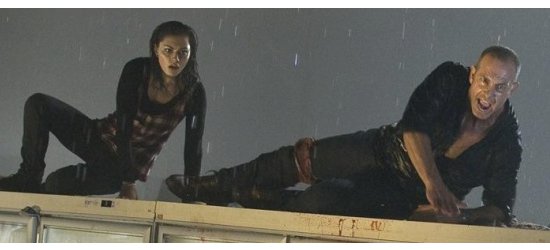
It may sound like heresy, that the slow-burning brilliance of Jaws (1975) — the pappa bear of the creature feature genre — might have achieved more bad than good for cinema history, at least if you look at films in the context of of quality and output.
Spielberg’s “we need a bigger boat” blockbuster inspired countless imitators. It sent a message to less talented directors that they too could make smart and scary feature films about brave idiots hunting down giant poorly operated machines posing as animals; that they too could turn the obviously ridiculous into the shockingly realistic. Countless duds, neither scary nor entertaining, ensued.
Plenty of filmmakers went the other way, cutting back dramatics and going hard on hoots and squeals: the gnarly bits, the blood splatters, the one-liners, the kick-ass moments of fist-in-the-air triumph.
In a genre marked by extremity, from the street and critical cred of Jaws to the give-em-what-they-want gore orgy of Piranha 3DD (2012), in many ways the epoch of balls-t0-the-wall schlock, any filmmaker broaching the creature feature must grapple with the following question: do I play this straight and serious, with perhaps an occasional wink to the audience, or am I in this for laughs?
For a movie about giant sharks that swim around supermarket car parks terrorizing survivors of a biblical-sized flood that smacks the Australian shoreline, the choice would seemingly be an easy one. Make it fast and snappy. Wet and wild. Keep tongue firmly in cheek. Don’t take yourself too seriously.
And yet SFX coordinator-cum-director Kimble Rendall chose the blue pill for Bait, a genre pic you might call “trashy” were it not for the stiffness with which its crazy-in-the-coconut premise is handled, stemming from the obvious belief Rendall has in the gravity of his material.
When shoppers (played by a cast including Xavier Samuel and Martin Sacks) get stranded, bobbing in the water amid shelves and tins of biccies like, well, bait, hatching plans to save themselves by dressing in ad-hoc armour consisting of metal baskets and bits ‘n’ bobs, Rendall treats it as a quasi-existential rumination on fate, displaced circumstance, interpersonal heart ache and so on, when all his target audience really wanted to see was sharks in a supermarket – a synopsis-on-the-back-of-a-match-box high concept if ever there was one.
Piranha 3DD demonstrated how these movies should be done, if they can’t be done seriously. Be outrageous. Be crazy. Crank that dial to 11, keep hurling blobs of pulp at the audience and see what sticks. The protection of parody and a pre-emptive dismantling of critical thinking provides insulation against naysayers; you can’t be seriously criticized, for example, because you never meant to be taken seriously.
Bait attempts genuine suspense, and fails, and also attempts trashy fun, and fails that too. It’s a messy, lumbering movie, slow to its feet (fins?) and with long pregnant dramatic pauses that give birth to more of the same.
For young and unfussy audiences it might work, and on a technical level Rendall gets things broadly right — particularly the central setting and the sharks. It’s the script, editing and lost at sea (ho ho) performances that slow things down, keeps the flood dripping through a thick filter of unwanted seriousness.
Sometimes a film critics job is to say: more mayhem. More craziness. If you can’t do sophistication, try silliness.
Bait’s Australian theatrical release date: September 20, 2012.








Crikey is committed to hosting lively discussions. Help us keep the conversation useful, interesting and welcoming. We aim to publish comments quickly in the interest of promoting robust conversation, but we’re a small team and we deploy filters to protect against legal risk. Occasionally your comment may be held up while we review, but we’re working as fast as we can to keep the conversation rolling.
The Crikey comment section is members-only content. Please subscribe to leave a comment.
The Crikey comment section is members-only content. Please login to leave a comment.